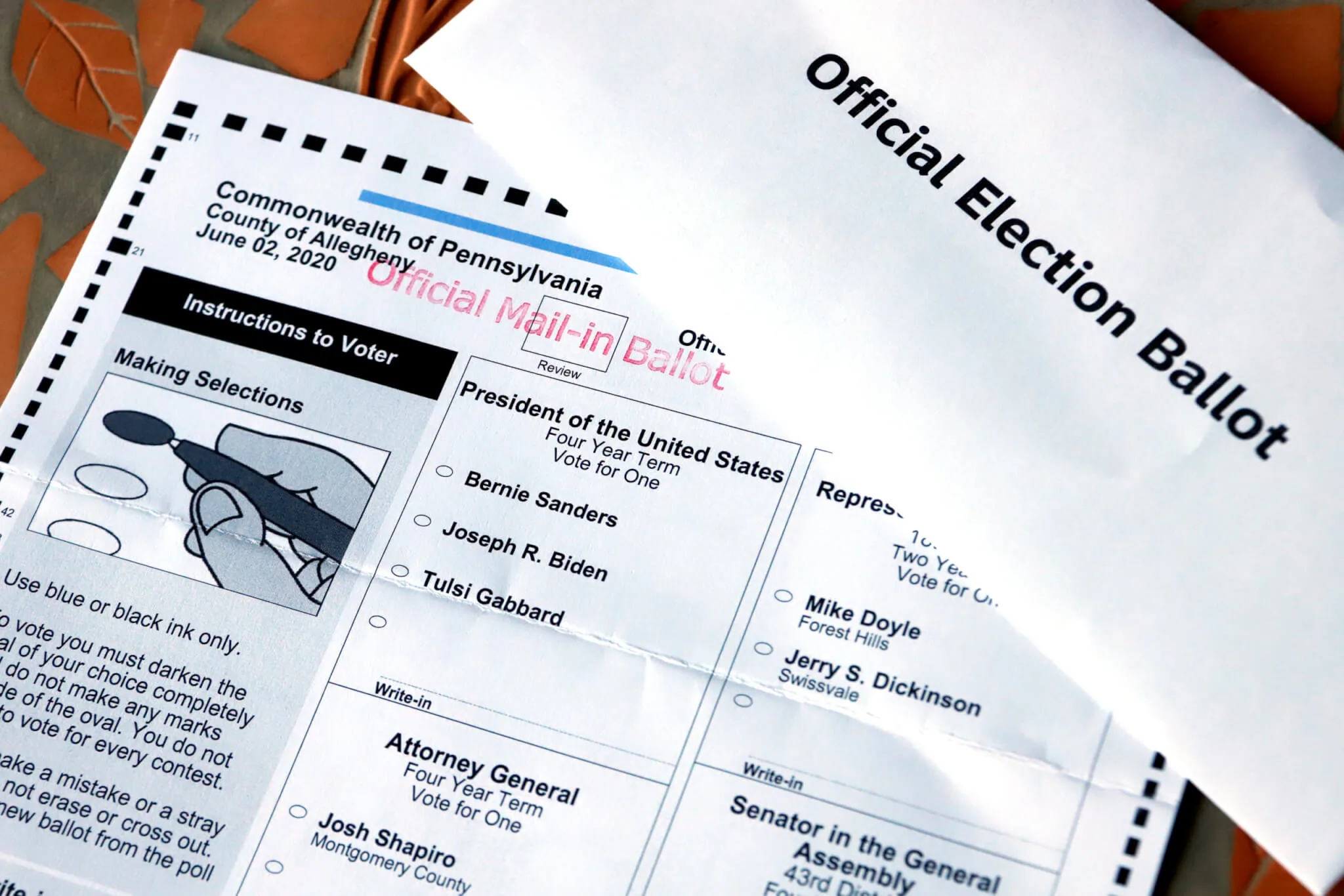
This May 26, 2020 file photo shows an Official Democratic General Primary mail-in ballot and secrecy envelope, for the Pennsylvania primary in Pittsburgh. (AP Photo/Gene J. Puskar/File)
A “naked ballot” is one that is not enclosed in a secrecy envelope before it is put in the mailing envelope. Elections officials have been ordered to throw out any “naked ballots.”
As Election Day approaches and millions of voters prepare to cast their ballots by mail, they run the risk of having their votes thrown out if they don’t follow the right steps.
A recent state Supreme Court ruling that election officials may not count “naked ballots” has officials and voting rights advocates concerned.
“Our fear is that people will not pay attention or won’t recognize the envelope for what it’s supposed to be and mislay it or forget to put it in. As soon as we saw that ruling, we went into instant action in terms of getting out information,” said Eileen Olmsted, spokesperson for the Pennsylvania League of Women Voters.
Olmsted said the voter education organization and its volunteers are using primarily social media campaigns to help voters understand what the secrecy envelope is and to use it.
“We realized that if people don’t recognize it, their vote is not going to be counted and that’s just one more huge barrier to having people have faith in the system,” Olmsted said.
What Is a “Naked Ballot?”
Mail-in ballots must be returned in two envelopes—a small secrecy envelope and a larger return envelope that has been signed by the voter—to be counted. Mail-in ballots returned without the required secrecy envelope have come to be known as “naked ballots.”
Why Are “Naked Ballots” a Problem?
Some voters did not put their mail-in ballots in the secrecy envelope during the primary election; elections officials in many counties disregarded the secrecy envelope requirement and counted the ballots, anyway.
A Sept. 17 ruling from the state Supreme Court requires elections officials to throw out any “naked ballots” in the upcoming general election.
Philadelphia City Commissioner Lisa Deeley, the city’s top election official, warned in September that “naked ballots” could “cause electoral chaos.”
Approximately 3 million Pennsylvanians are expected to vote by mail in November. If 1% of them do not use the secrecy envelopes, that’s 30,000 ballots tossed out. If 5% do not use the secrecy envelopes, that’s 150,000 ballots tossed out. (The general election Pennsylvania in 2016 was decided by just over 44,000 votes.)
If that many ballots are tossed out in a battleground state like Pennsylvania, legal disputes could follow that could disrupt the whole election.
How Would You Know if Your Ballot is Rejected Because it’s Missing its Secrecy Envelope?
Voters can check with their county election office to find out if their ballots have been accepted, said Wanda Murren, a spokesperson for the state Department of State, but the information will not be available until ballots are canvassed.
Election officials may not canvass ballots before Election Day.
Currently, no process exists in the state code for ballots submitted without a secrecy envelope, Murren said.
Election officials in some counties have said they will try to work with voters.
Bucks County Chief Clerk Gail Humphrey told The Keystone that county elections officials will notify voters by email, phone, or postcard mailings if their ballots are rejected.
Provided voters get the notice on or before 8 p.m. on Nov. 3, they will have the option to recast their vote by going to the board of elections, asking to have their first ballot voided, and requesting a new ballot. The completed ballot can then be submitted on the spot, mailed, or deposited at an official drop-off location within the county.
“We’re going to do everything we can to make sure that everyone who wants to exercise their right to vote in Bucks County has their vote counted,” Humphrey said.
How Can Mail-in Voters Ensure Their Ballots are Counted?
First, fill out the ballot using a black pen.
Next, place the ballot inside the smaller secrecy envelope and seal it. This is the plain white envelope with the words “Official Election Ballot” on it.
Then, place the secrecy envelope containing the ballot inside the larger return envelope. Complete the voter’s declaration on the back of the return envelope, sign it, and write the date.
Finally, submit the ballot. You can put it in your mailbox, an official US Postal Service mailbox, or an official secure ballot drop box. You can also take it to the county elections office and deliver it in person. You may not have a friend or family member deliver it for you.
At this time, mail-in ballots must be postmarked by 8 p.m. (the time polls close) on Election Day and must arrive at your county elections office by 5 p.m. Nov. 6.
However, Republicans are challenging that deadline, and seeking to require all mail-in ballots to arrive at local elections offices by 5 p.m. on Election Day. They are also seeking to eliminate ballot drop boxes.
The earlier you submit your ballot, the more likely it will be counted.

For Rep. Susan Wild, supporting PA families includes reproductive rights and much more
Rep. Susan Wild wants to be very clear with Pennsylvanians: Donald Trump is committed to taking away women’s reproductive freedom, but he is not...

School districts working with anti-LGBTQ groups can cost your kids’ schools millions
Parents across South Central Pennsylvania are worried about the potential financial impacts working with anti-LGBTQ groups may have on their school...

VIDEO: Trump distances himself from his anti-abortion views
Donald Trump appeared on WGAL on Tuesday and continued to distance himself from his anti-abortion views claiming that reproductive rights are now a...

VIDEO: Community pushback gets school board to rescind decision on denying gay actor’s visit
Cumberland Valley School Board offered a public apology and voted to reinstate Maulik Pancholy as a guest speaker a week after the board voted to...

VIDEO: Project 2025 brings nuclear armageddon back into vogue
Project 2025 is a titanic document, with plans ranging from cutting half of all government employees to targeting reproductive rights on a scale...



